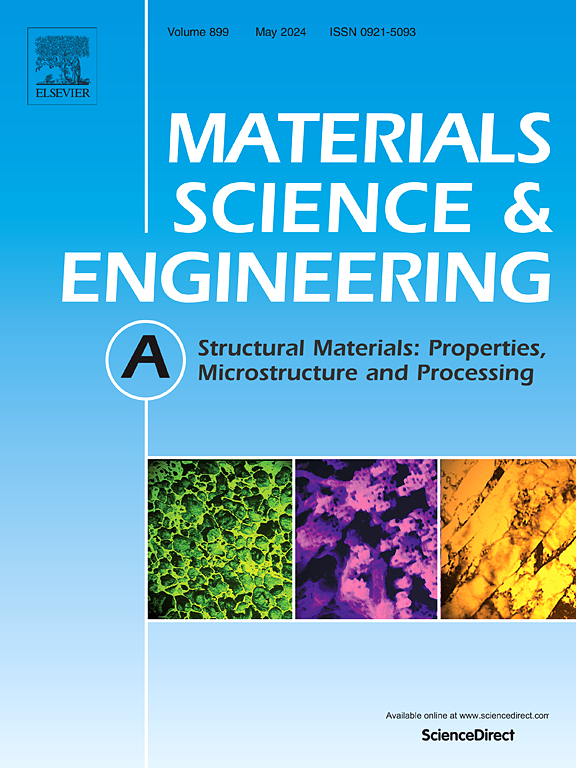Microstructural evolution and mechanical properties of Y2O3 reinforced IN718 superalloys fabricated by laser directed energy deposition
IF 6.1
2区 材料科学
Q1 MATERIALS SCIENCE, MULTIDISCIPLINARY
引用次数: 0
Abstract
Laser directed energy deposition (LDED) presents a promising approach for fabricating and repairing intricate components made from oxide dispersion-strengthened nickel-based superalloys. However, the evolution of oxides during the LDED process and their contributions to the mechanical properties remain insufficiently explored. This study investigated the effects of Y2O3 additions on the microstructure and mechanical properties of as-received and heat-treated states IN718 alloys and the evolution mechanism of Y2O3 in the melt pool. During the LDED process, a certain fraction of Y2O3 melts and decomposes in the melt pool, reacting in situ with Al to form Al2O3-Y4Al2O9 composite oxides. The Y2O3 and composite oxide nanoparticles act as heterogeneous nucleation sites, refining the dendritic and grain structures. With increasing the Y2O3 addition, the strength of the alloys increases. Notably, the IN718 alloys with 1.0 wt% Y2O3 achieve the optimal strength-toughness balance, elevating the room temperature yield strength by 35.7% compared to the as-received sample without Y2O3 addition. After heat treatment, the IN718 alloys with 1.0 wt% Y2O3 elevate the room temperature yield strength by 4.9% and the high temperature yield strength by 13.4% while exhibiting a more pronounced dynamic strain aging effect than the sample without Y2O3 addition. Besides, the oxides showcase a certain deformability owing to the presence of dislocations in the interior, thereby preventing the crack nucleation near the oxides upon tensile straining. This study provides novel insights into enhancing the mechanical properties of additively manufactured IN718 alloys.
激光定向能沉积制备Y2O3增强IN718高温合金的组织演变及力学性能
激光定向能沉积(LDED)为制造和修复由氧化物弥散增强镍基高温合金制成的复杂部件提供了一种很有前途的方法。然而,氧化物在led过程中的演变及其对机械性能的贡献仍然没有得到充分的探讨。研究了Y2O3添加量对IN718合金接收态和热处理态组织和力学性能的影响,以及Y2O3在熔池中的演化机制。在LDED过程中,一定比例的Y2O3在熔池中熔化分解,与Al原位反应生成Al2O3-Y4Al2O9复合氧化物。Y2O3和复合氧化物纳米颗粒作为非均相成核位点,细化了枝晶和晶粒结构。随着Y2O3添加量的增加,合金的强度增加。值得注意的是,添加1.0 wt% Y2O3的IN718合金达到了最佳的强度-韧性平衡,与未添加Y2O3的样品相比,室温屈服强度提高了35.7%。经热处理后,添加1.0 wt% Y2O3的IN718合金室温屈服强度提高4.9%,高温屈服强度提高13.4%,动态应变时效效果比未添加Y2O3的IN718合金明显。此外,由于内部存在位错,氧化物表现出一定的变形能力,从而防止了拉伸应变时氧化物附近的裂纹形核。本研究为提高增材制造IN718合金的力学性能提供了新的见解。
本文章由计算机程序翻译,如有差异,请以英文原文为准。
求助全文
约1分钟内获得全文
求助全文
来源期刊

Materials Science and Engineering: A
工程技术-材料科学:综合
CiteScore
11.50
自引率
15.60%
发文量
1811
审稿时长
31 days
期刊介绍:
Materials Science and Engineering A provides an international medium for the publication of theoretical and experimental studies related to the load-bearing capacity of materials as influenced by their basic properties, processing history, microstructure and operating environment. Appropriate submissions to Materials Science and Engineering A should include scientific and/or engineering factors which affect the microstructure - strength relationships of materials and report the changes to mechanical behavior.
 求助内容:
求助内容: 应助结果提醒方式:
应助结果提醒方式:


